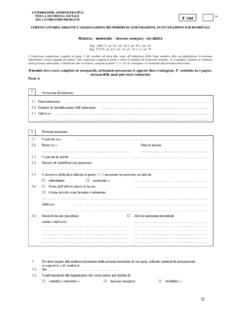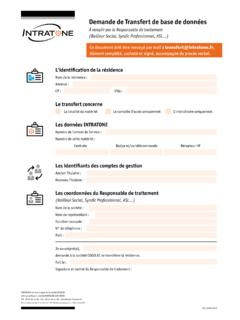Transcription of T ips on S ervin g C ustom ers w ith D isab ilities.
1 Accessible Schools. Leading the on ServingCustomers ONTARIO CUSTOMER SERVICEHow to Welcome Customers with you know that just over of Ontarians have a disability? That s 1 in every 7 Ontarians and as the population ages that number will with disabilities, along with their families and friends, travel, shop, do business, engage in activities in the community, send their children to the local school and attend school events, just like everyone else. By providing service that welcomes people with disabilities, you can offer better service to everyone. Treating all the people who come to our schools and board offices with individual respect and courtesy is at the heart of excellent customer are some ways you can provide better service to your customers with disabilities:2 Treat people with disabilities with respect and consideration.
2 Patience, optimism, and a willingness to find a way to communicate are your best tools. Smile, relax, and keep in mind that people with disabilities want to experience helpful customer service. Don t make assumptions about what type of disability or disabilities a person has. Some disabilities are not visible. Take the time to get to know your customers needs. Be patient. People with some kinds of disabilities may take a little longer to understand and respond. If you re not sure what to do, ask your customer, How May I help you? If you can t understand what someone is saying, just politely ask again. Ask before you offer to help don t just jump in. Your customers with disabilities know if they need help and how you can provide it. Find a good way to communicate. A good start is to listen carefully. Look at your customer, but don t stare.
3 Speak directly to a person with a disability, not to their interpreter or someone who is with them. Use plain language and speak in short sentences. Don t touch or address service animals they are working and have to pay attention at all times. Ask permission before touching a wheelchair or a piece of equipment. Every business should have emergency procedures for customers with disabilities. Make sure you know what they DisabilitiesA person who is deaf-blind cannot see or hear to some extent. This results in greater difficulties in accessing information and managing daily activities. Most people who are deaf-blind will be accompanied by an intervenor, a professional who helps with communicating. Intervenors are trained in special sign language that involves touching the hands of the client in a two-hand, manual alphabet or finger spelling, and may guide and interpret for their DisabilitiesThere are many kinds of disabilities.
4 They can be visible, hidden, permanent or occur only at certain times. Here are some types of disabilities:Disabilities vary. Being hard of hearing is different from being Deaf. Having low vision is different from being legally blind. A disability can happen to anyone at anytime. Some people are born with a disability. For others, the disability results from an illness or an accident. Sometimes it happens because the person is getting older. In fact, as our population ages, many of us may eventually face some kind of limitation. According to Statistics Canada, by 2031, seniors will account for between 23% and 25% of the total population. That s double the current senior proportion of 13%. Don t assume what a person can or cannot do. Some people who are deaf-blind have some sight or hearing, while others have neither. A customer who is deaf-blind is likely to explain to you how to communicate with them or give you an assistance card or a note explaining how to communicate with them.
5 Speak directly to your customer as you normally would, not to the intervenor. Identify yourself to the intervenor when you approach your customer who is deaf-blind. Don t touch or address service animals they are working and have to pay attention at all times. Never touch a person who is deaf-blind suddenly or without permission unless it s an emergency. deaf-blind hearing intellectual developmental learning mental health physical speech or language visionHere are some tips on serving customers who are deaf-blind:Hearing ImpairmentsPeople who have hearing loss may be deaf or hard of hearing. Like other disabilities, hearing loss has a wide variety of degrees. People who are hearing impaired may require assistive devices when communicating. They may also use e-mail, pagers, TTY telephone service or Bell Canada Relay or Developmental DisabilitiesPeople with intellectual or developmental disabilities may have difficulty doing many things most of us take for granted.
6 These disabilities can mildly or profoundly limit one s ability to learn. You may not be able to know that someone has this disability unless you are told, or you notice the way people act, ask questions or use body with an intellectual or developmental disability may understand more than you think. They will appreciate the respect and consideration that you show them. Always ask how you can help. Don t shout. Attract the customer s attention before speaking. The best way is a gentle touch on the shoulder or gently waving your hand. Make sure you are in a well-lighted area where your customer can see your face. Look at and speak directly to your customer. Address your customer, not their interpreter. If necessary, ask if another method of communicating would be easier, for example a pen and paper. Don t put your hands in front of your face when speaking.
7 Be clear and precise when giving directions, and repeat or rephrase if necessary. Make sure you have been understood. Don t touch or address service animals they are working and have to pay attention at all times. Any personal ( , financial) matters should be discussed in a private room to avoid other people overhearing. Be patient. Communication for people who are deaf may be different because their first language may not be English. It may be American Sign Language (ASL). If the person uses a hearing aid, try to speak in an area with few competing sounds. 5 Here are some tips on serving customers who are deaf or hard of hearing:Learning DisabilitiesLearning disabilities can result in a host of different communications difficulties for people. They can be subtle, as in having difficulty reading, or they can be more pronounced.
8 They can interfere with a person s ability to receive, express or process information. You may not be able to know that someone has a learning disability unless you are told, or notice the way a person acts, asks questions or uses body language. Don t assume what a person can or cannot do. Use plain language and speak in short sentences. Make sure your customer understands what you ve said. If you can t understand what s being said, don t pretend. Just ask again. Provide one piece of information at a time. Be supportive and patient. Speak directly to your customer, not to their companion or attendant. Patience and a willingness to find a way to communicate are your best tools. When you know that someone with a learning disability needs help, ask how you can best help. Speak normally and clearly, and directly to your customer.
9 Take some time people with some kinds of learning disabilities may take a little longer to understand and respond. Try to find ways to provide information in a way that works best for them. For example, have a paper and pen handy. If you re dealing with a child, be patient, encouraging and supportive. Be courteous and patient and your customer will let you know how to best provide service in a way that works for them. 6 Here are some tips on serving customers who have an intellectual or developmental disability:Here are some tips on serving customers who have learning disabilities:7 Mental Health DisabilitiesIt is possible that you will not recognize a person with a mental health disability unless you are informed of it. Therefore, usually, it will not affect customer service at if someone is experiencing difficulty in controlling their symptoms or is in a crisis, you may need to help out.
10 Be calm and professional and let your customer tell you how you can best DisabilitiesThere are many types and degrees of physical disabilities, and not all require a wheelchair. People who have arthritis, heart or lung conditions or amputations may also have difficulty with moving, standing or sitting. It may be difficult to identify a person with a physical disability. Treat a person with a mental health disability with respect and consideration. Be confident and reassuring. Listen carefully and work with your customer to meet their needs. If someone appears to be in a crisis, ask them to tell you the best way to help. Speak normally and directly to your customer. Don t speak to someone who is with them. People with physical disabilities often have their own ways of doing things. Ask before you help. Be patient. Customers will identify their needs to you.






